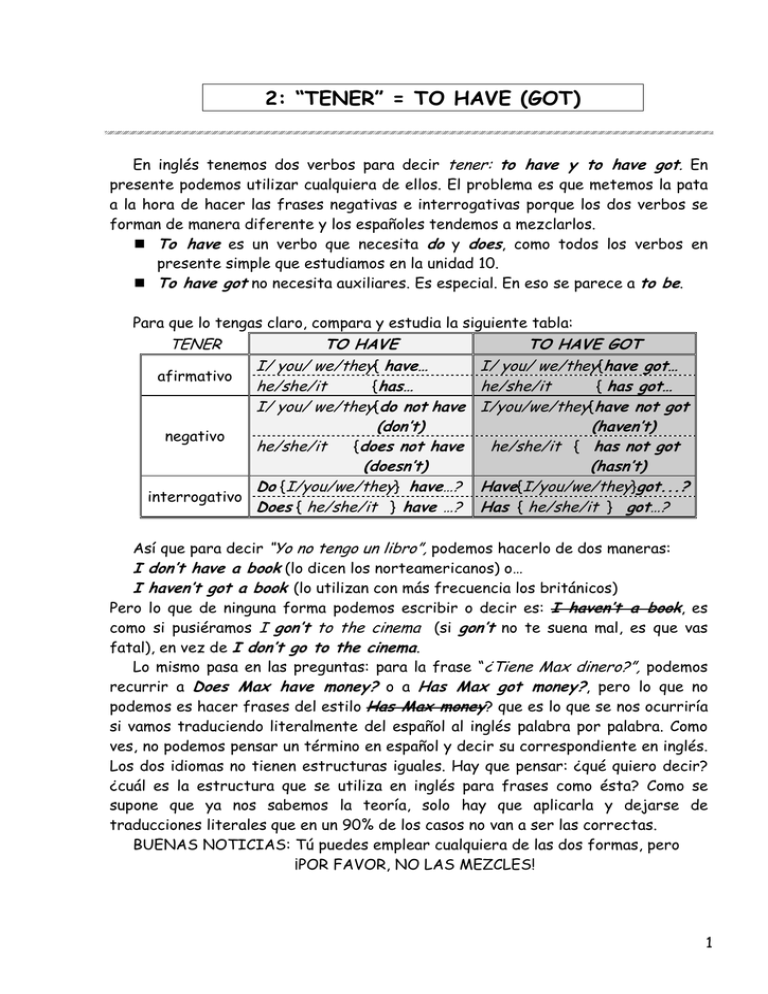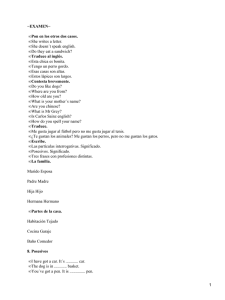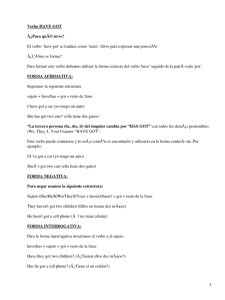2: “TENER” = TO HAVE (GOT)
Anuncio

2: “TENER” = TO HAVE (GOT)
En inglés tenemos dos verbos para decir tener: to have y to have got. En
presente podemos utilizar cualquiera de ellos. El problema es que metemos la pata
a la hora de hacer las frases negativas e interrogativas porque los dos verbos se
forman de manera diferente y los españoles tendemos a mezclarlos.
To have es un verbo que necesita do y does, como todos los verbos en
presente simple que estudiamos en la unidad 10.
To have got no necesita auxiliares. Es especial. En eso se parece a to be.
Para que lo tengas claro, compara y estudia la siguiente tabla:
TENER
TO HAVE
I/ you/ we/they{ have…
afirmativo
he/she/it
{has…
I/ you/ we/they{do not have
(don’t)
negativo
he/she/it
{does not have
(doesn’t)
Do {I/you/we/they} have…?
interrogativo
Does { he/she/it } have …?
TO HAVE GOT
I/ you/ we/they{have got…
he/she/it
{ has got…
I/you/we/they{have not got
(haven’t)
he/she/it { has not got
(hasn’t)
Have{I/you/we/they}got...?
Has { he/she/it } got…?
Así que para decir “Yo no tengo un libro”, podemos hacerlo de dos maneras:
I don’t have a book (lo dicen los norteamericanos) o…
I haven’t got a book (lo utilizan con más frecuencia los británicos)
Pero lo que de ninguna forma podemos escribir o decir es: I haven’t a book, es
como si pusiéramos I gon’t to the cinema (si gon’t no te suena mal, es que vas
fatal), en vez de I don’t go to the cinema.
Lo mismo pasa en las preguntas: para la frase “¿Tiene Max dinero?”, podemos
recurrir a Does Max have money? o a Has Max got money?, pero lo que no
podemos es hacer frases del estilo Has Max money? que es lo que se nos ocurriría
si vamos traduciendo literalmente del español al inglés palabra por palabra. Como
ves, no podemos pensar un término en español y decir su correspondiente en inglés.
Los dos idiomas no tienen estructuras iguales. Hay que pensar: ¿qué quiero decir?
¿cuál es la estructura que se utiliza en inglés para frases como ésta? Como se
supone que ya nos sabemos la teoría, solo hay que aplicarla y dejarse de
traducciones literales que en un 90% de los casos no van a ser las correctas.
BUENAS NOTICIAS: Tú puedes emplear cualquiera de las dos formas, pero
¡POR FAVOR, NO LAS MEZCLES!
1
TO HAVE GOT en afirmativo
Sujeto Presente Simple Forma corta
Español
I
have got
I've got
yo tengo
you
have got
you've got
tu tienes
he
has got
he's got
él tiene
she
has got
she's got
ella tiene
it
has got
it's got
tiene
Sujeto
I
you
he
she
it
we
they
we
have got
we've got
they
have got
they've got
Presente Simple
have not got
have not got
has not got
has not got
has not got
have not got
have not got
nosotros
tenemos
ellos tienen
TO HAVE GOT en negativo
Forma corta
I've not got/I haven't got
you've not got/you haven't got
he's not got/ he hasn't got
she's not got/she hasn't got
it's not got/it hasn't got
we've not got/we haven't got
they've not got/they haven't got
Español
yo no tengo
tu no tienes
él no tiene
ella no tiene
no tiene
nosotros notenemos
ellos no tienen
TO HAVE GOT en interrogativo
Presente Simple
Have I got?
Have you got?
Has he got?
Has she got?
Has it got?
Have we got?
Have they got?
Español
¿Yo tengo?
¿Tu tienes?
¿Él tiene?
¿Ella tiene?
¿Tiene?
¿Nosotros tenemos?
¿Ellos tienen?
A.- TRADUCE AL INGLÉS DE LAS DOS FORMAS POSIBLES
1.- El abuelo de Peter tiene perro.
(to have) ____________________________________
(to have got) _________________________________
2.- Tienes una casa muy bonita.
(to have) ____________________________________
(to have got) _________________________________
3.- Ese hombre tiene un sombrero marrón.
(to have) ____________________________________
(to have got) _________________________________
4.- Estos chicos tienen deberes.
(to have) ____________________________________
(to have got) _________________________________
1
B.- PON LAS FRASES DEL EJERCICIO ANTERIOR EN NEGATIVO
1.- (to have) ____________________________________
(to have got) _________________________________
2.- (to have) ____________________________________
(to have got) _________________________________
3.- (to have) ____________________________________
(to have got) _________________________________
4.- (to have) ____________________________________
(to have got) _________________________________
C.- AHORA HAZLAS COMO FRASES INTERROGATIVAS
1.- (to have) ____________________________________
(to have got) _________________________________
2.- (to have) ____________________________________
(to have got) _________________________________
3.- (to have) ____________________________________
(to have got) _________________________________
4.- (to have) ____________________________________
(to have got) _________________________________
Ya hemos dicho que no mezcles las dos estructuras. Recuérdalo en las
RESPUESTAS CORTAS. Si la pregunta es
Do you have ….? la respuesta será Yes, I do/No, I don’t.
Pero si preguntas
Have you got….? Deberás contestar Yes, I have/ No I haven’t
D.- CONTESTA CORRECTAMENTE CON LA FORMA CORTA.
1.- Have you got a dog? ______________________
2.- Does a spider have seven legs? ______________
3.- Has Spain got mountains? __________________
4.- Do the Italians have a king? ________________
5.- Have your teachers got books? ______________
6.- Has Ronaldo got much money? _______________
7.- Does Real Madrid have 2 titles? _____________
8.- Do you have 100 books in your bag? ___________
9.- Have you got 100 pencils here? ______________
10.-Have I got a blue school bag? _______________
1
* El verbo to have tiene en español el significado principal de tener pero en
algunos casos se puede traducir por tomar. Conoceremos la traducción apropiada
dependiendo del sentido de la frase.
I have a new car = Tengo un coche Nuevo.
I have coffee = Tomo café. (con bebidas y alimentos en general).
* En otros contextos lo traducimos como dar:
We don’t have the party at home = No damos la fiesta en casa
Do we have a walk? = ¿Damos un paseo?
* A veces ni siquiera se traduce :
She has a shower/bath = Ella se ducha/baña.
Do you have a rest = ¿Descansas?
breakfast
desayunamos
We don’t have { lunch } today = Nosotros no { comemos } hoy.
dinner
cenamos
* Hay ocasiones en que tener no se dice con to have:
Tener hambre = to be hungry
Tener frío
= to be cold
Tener sed
= to be thirsty
Tener calor = to be hot
(esto ya lo vimos ¿te acordabas?
* To have también se utiliza como auxiliar de los tiempos perfectos, pero eso
ya es para nota. You have drunk = Has bebido. Lo veremos en otra unidad (el
presente perfecto, no lo de la bedida).
* Lo podemos traducir como tener que o deber de cuando va seguido de la
preposición to, pero eso lo estudiaremos en los verbos modales. You have to
study English = Tienes que/debes de estudiar inglés (¿me equivoco?)
F.- TRADUCE Y CONTESTA
1.- ¿Tienes hambre o sed? __________________________________________
2.- ¿Cuándo desayuna tu hermano? ____________________________________
3.- ¿Tienes frío en verano? _________________________________________
4.- ¿Qué coméis los domingos en casa? _________________________________
5.-¿Dan ellos un paseo por la noche? __________________________________
6.- ¿Da Helen una fiesta el jueves? ___________________________________
7.- ¿Dónde tienes la bici? __________________________________________
8.- ¿Cuántos años tienes? __________________________________________
1

